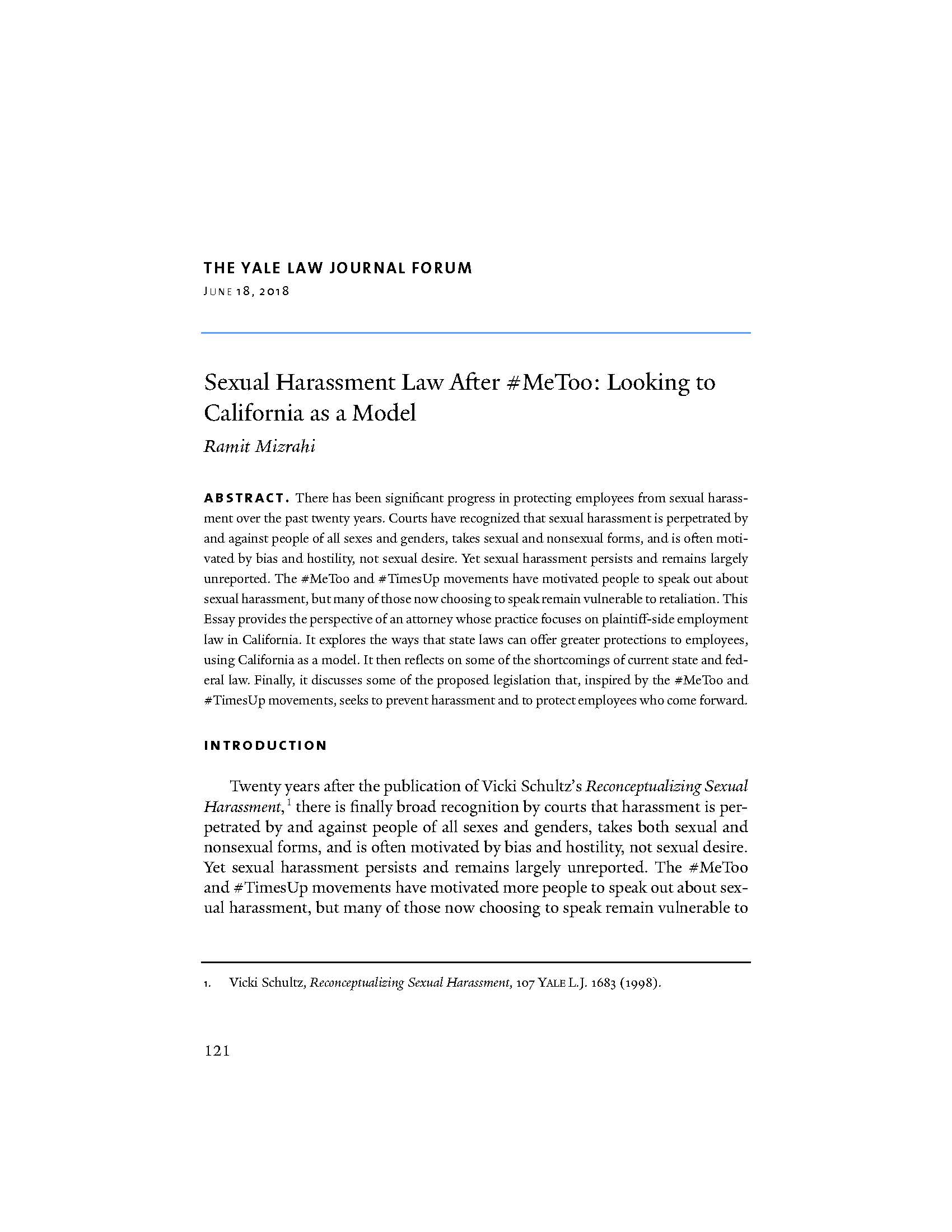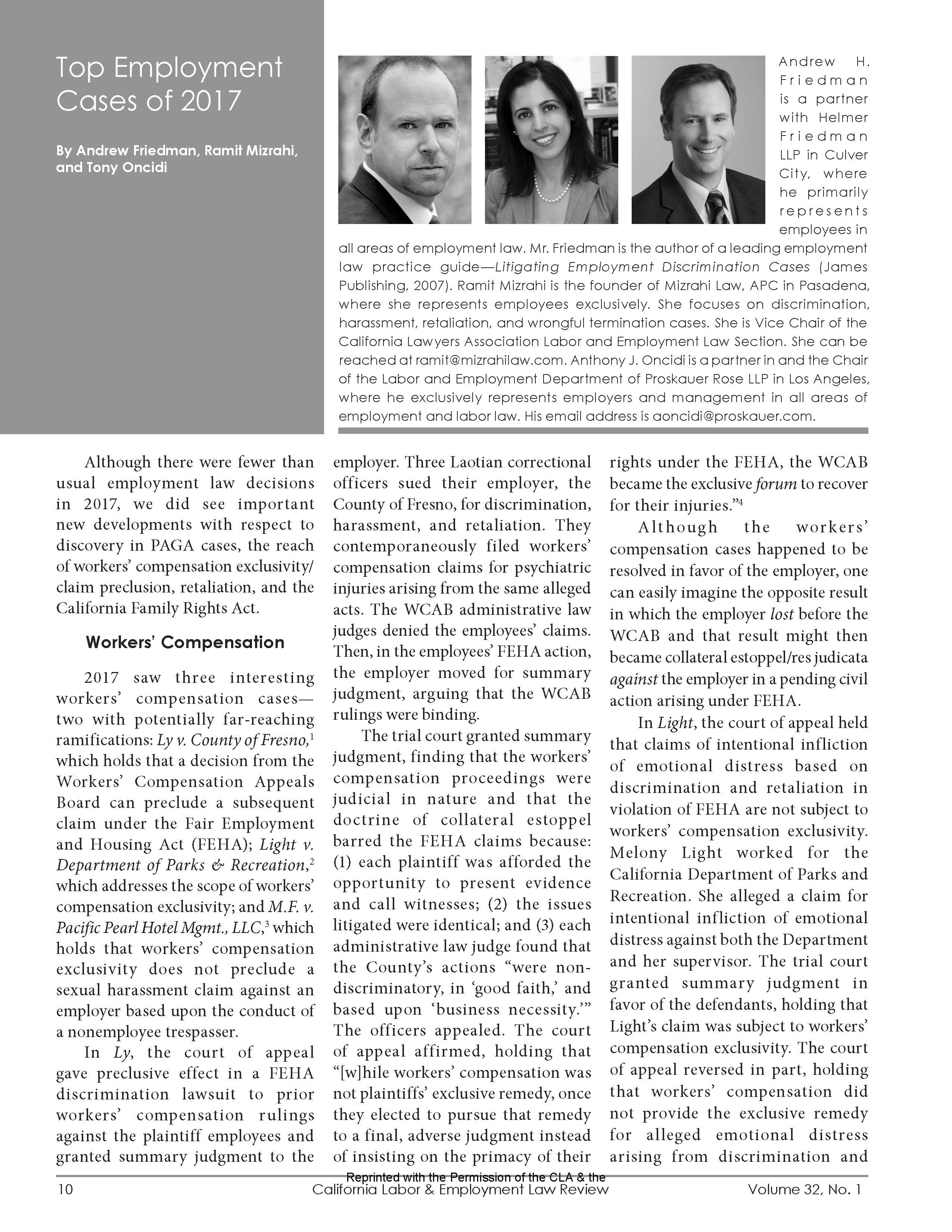-
Less than a month before the movie “The Predator” was released, actress Olivia Munn learned that fellow actor Steven Wilder Striegel was a registered sex offender. She reported the information to the studio, and in response the studio pulled the scenes involving the actor. But, it turns out that The Predator’s director Shane Black was friends with Striegel and knew of his status as a registered sex offender before casting him in the movie. He never told Munn or anyone else involved in the production. And while the scene was cut, Munn has felt ostracism from her peers since she made her report.
This situation raises interesting questions about employers’ obligations to protect other employees and prevent sexual harassment. Below, I discuss some of the key laws that apply.
The Fair Employment and Housing Act Creates a Duty to Prevent Workplace Harassment
The California Fair Employment and Housing Act (FEHA), Government Code § 12940, prohibits workplace sexual harassment and other forms of harassment and discrimination based on protected categories. An employer is strictly liable for sexual harassment by a supervisor. It is also liable for harassment by coworkers, subordinates, and even nonemployees if it knew or should have known of the harassment and failed to take immediate and appropriate corrective action. An employer is also separately liable for failing to take all reasonable steps necessary to prevent discrimination and harassment from occurring.
This means that an employer faces significant exposure under the FEHA if it knowingly employs a sexual harasser or sex offender and fails to take actions to protect its other employees from sexual harassment by that person.
Megan’s Law Establishes a Sex Offender Registry, But Limits the Use of Such Information in Employment To Protecting Persons at Risk
California’s Megan’s Law, Penal Code § 290.46, requires the California Department of Justice to maintain a website that identifies individuals convicted of specific sex offenses. The Megan’s Law Website includes the following information about the sex offenders listed in the registry: their name and known aliases, a photograph, a physical description, including gender and race, date of birth, criminal history, prior adjudication as a sexually violent predator, the address at which the person resides, and any other information that the Department of Justice deems relevant. Crimes that trigger a listing in the registry include: rape, sexual battery, sexual trafficking of minors, and sex crimes involving children. Certain sex offenders may apply to have their information removed from the website…
-

Ramit Mizrahi has been recognized in U.S News & World Report’s 2019 Edition of The Best Lawyers in America© for her work in employment law representing individuals.
Ms. Mizrahi has also been selected to the 2019 Southern California Super Lawyers® list, again for her work in employment law representing individuals.
Both honors reflect peer recognition of excellence in practice.
This marks the seventh year that Ms. Mizrahi has been recognized by Super Lawyers®, including having previously been distinguished as being among the top 100 Rising Stars and top 50 Rising Stars women for three consecutive years.
Ms. Mizrahi remains committed to serving as a tenacious advocate for her clients while working to build collegiality and community in the legal profession.
-
On June 18, 2018, Ramit Mizrahi’s essay, Sexual Harassment Law After #MeToo: Looking to California as a Model, was published in the Yale Law Journal Forum. The essay is part of a Collection by the Yale Law Journal and the Stanford Law Journal on #MeToo and the Future of Sexual Harassment Law. Ms. Mizrahi’s essay is the only one in the Collection that gives the perspective of a practicing lawyer and is not written by a legal scholar.
Drawing from her extensive experience representing employees in sexual harassment cases, Ms. Mizrahi discusses the evolution of the law, including the impact of the #MeToo and #TimesUp movements, current shortcomings, and proposed legislation in California that would help prevent harassment and protect employees who come forward. This is Ms. Mizrahi’s second piece on sexual harassment law that the Yale Law Journal has published. The first was “Hostility to the Presence of Women”: Why Women Undermine Each Other in the Workplace and the Consequences for Title VII, Note, 113 Yale L.J. 1579 (2004).
The essay
Sexual Harassment Law After #MeToo: Looking to California as a Model can be found here. You can also click on the below image for the link to the pdf version: -

On April 12, 2018, Ramit Mizrahi will be moderating a panel at the California Lawyers Association’s 35th Annual Labor and Employment Law Conference. Here are the panel details:
Naughty Clients, Ethical Lawyers (What To Do When Your Client Does Something Bad)
(1.25 HOURS LEGAL ETHICS)Description: Practice law long enough and you will inevitably find yourself wondering how to deal with sticky situations that are created, intentionally or inadvertently, by your clients. In this engaging panel, we will discuss some difficult situations that come up and how to best deal with them, including discovering that clients: took documents that they may not be entitled to possess, deleted documents that should have been retained, did not disclose key facts to counsel, made misrepresentations, recorded conversations without consent, made possibly extortionate statements, and engaged in other behaviors that lawyers would consider as “crossing the line.”
Date and time: April 12, 2018, 12:45 p.m.– 2:00 p.m.
Location: JW Marriott Union Square, 515 Mason St., San Francisco, CA.
Additional information can be found on the Labor & Employment Law Annual Meeting and Public Sector Conference page.
-
The January 2018 issue of the California Lawyers Association’s Labor & Employment Law Review features an article authored by Andrew Friedman, Ramit Mizrahi, and Tony Oncidi.
The article—”The Top Employment Cases of 2017″— highlights the most important California state and federal employment cases from last year. Click on the below image to read the article in full.
-

On March 1, 2018, Ramit Mizrahi will be presenting at the California Lawyers Association’s Employment Law 101 conference. The conference is designed to teach fundamentals to lawyers new to employment law. She will be presenting on two panels: harassment, discrimination & retaliation (9-10:30 a.m.) and leave law compliance (1:15-2:45 p.m.).
Date and time: March 1, 2018, 9 a.m.– 4:30 p.m.
Location: The State Bar of California, 845 S. Figueroa St., Los Angeles, CA 90017.
-

On December 22, Ramit Mizrahi appeared on AirTalk (hosted by Larry Mantle) at KPCC to discuss how companies are using Facebook to target ads to younger employees, and how this can run afoul of anti-discrimination laws.The episode can be found here: Age discrimination lawsuit against big employers exposes snag in Facebook’s targeted ad system.
More Of Ramit’s Thoughts On Why Targeted Job Ads Are So Troubling
Gone are the days when people would get the local paper to scope out job ads. These days, most jobs are posted online. While there are dedicated job sites like Monster or CareerBuilder, employers are increasingly posting on Facebook.
There are many benefits to using Facebook to post jobs ads. Many potential employees are not on LinkedIn and do not have résumés posted online. Facebook has nearly 2 billion users who can be reached, including people who may not be looking to change their job situation but may be enticed to make a change. In addition, employers have the ability to microtarget, limiting their ads to people with specific interests or experience, enabling them to seek out the employees they believe will be most suitable for jobs.
Targeting Job Ads By Age Can Be Devastating to Older Workers
The problem is that employers can target ads to viewers not only by interests but also by protected characteristics, including age and gender. Working in collaboration, Propublica and the New York Times revealed that dozens of large companies–including Verizon, Amazon, UPS, and even Facebook itself–were posting job ads on Facebook that were visible only to those in certain age ranges (to give some examples, 18-24, 25-36, 27-40, and 25 to 60).
Such a practice makes job postings invisible to older workers. This means that they may never
-

On October 21, 2017, Ramit Mizrahi will once again be speaking about the year’s most important employment law cases. The panel will be part of the California Employment Lawyers Association’s 30th Annual Employment Law Conference. She will be speaking alongside Andrew H. Friedman of Helmer Friedman, LLP.
Date and time: October 21, 2017, 10 a.m.–12:05 p.m.
Location: Oakland Marriott City Center
Additional information can be found on the CELA events page.
-

Despite the federal Equal Pay Act of 1963 being on the books for over 50 years and California having its own Equal Pay Act, the gender wage gap has persisted.
According to research cited by the California legislature, women in California still earn 84 cents for every dollar earned by a male counterpart. This is sightly better than the nationwide average of 80 cents. The wage gap is even wider for women of color (for example, African-American women earn 63 cents and Latinas earn 54 cents per male dollar). Closing the wage gap would give an additional $8,000 on average to each working woman in California—an additional $39 billion in total, benefiting families and the economy.
As I have written before, one of the reasons that the wage gap persists is that women’s lower prior salary is used to justify paying them less at new jobs. This means that a new employer without intentional bias can perpetuate the pay gap by relying on what may have been the result of bias elsewhere. The lifetime cost to women can be tremendous.
AB-168, authored by Assemblymember Susan Talamantes Eggman (D-Stockton) and signed into law by Governor Brown, seeks to close the gender pay gap. The newly enacted bill adds California Labor Code section 432.3.
Under section 432.3, effective January 1, 2018:
- Employers can no long ask job applicants about their salary history, including compensation and benefits.
- Employers can no longer consider prior salary as a factor in determining whether to offer an applicant a job or what salary to set for the position.
- Employers are required, upon request, to provide a job applicant with the pay scale for the position.
- A job applicant may still decide to voluntarily (without prompting) disclose their salary history information, and employers may consider voluntarily disclosed information when setting compensation.
The bill applies to all California employers, private and public.
Exempt from Section 432.3 is salary information that is subject to public disclosure pursuant to state and federal law, including the California Public Records Act and the Freedom of Information Act.
Hopefully, this new law will have a major impact on closing the wage gap.
-

UPDATE: On January 1, 2021, the California Family Rights Act (“CFRA”) was expanded to cover employees who work for employers with five or employees; as a result the New Parent Leave Act was rendered unnecessary and was repealed. While the New Parent Leave Act was short-lived, it was a stepping stone to provide more new parents with leave rights.
Read more about SB 1383, which expanded the CFRA, here.
Expansion of bonding rights for California parents
Thanks to the SB-63, introduced by Senator Hannah-Beth Jackson, California parents who work for smaller employers will now be allowed to take up to 12 weeks of unpaid job-protected leave to bond with a new child. During that time, their employers will be required to continue their group health coverage benefits. Government Code Section 12945.6, known as the New Parent Leave Act, will make bonding leave available to millions of additional workers — an estimated 16% of the California workforce who did not previously have this right.
Eligibility requirements
To be eligible for the 12 weeks of leave under the New Parent Leave Act, the following criteria apply:
- The employee must have at least 12 months of service with the employer;
- The employee must have at least 1,250 hours of service during the prior 12 months; and
- The employee must works at a worksite with at least 20 employees within 75 miles.
The employee can take the bonding leave within one year of a child’s birth, adoption, or foster care placement.
Existing law, the California Family Rights Act (“CFRA”), provides similar parental leave rights…



